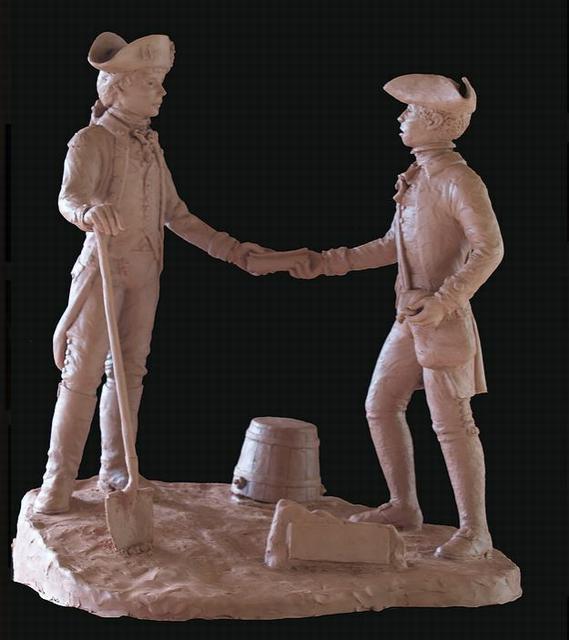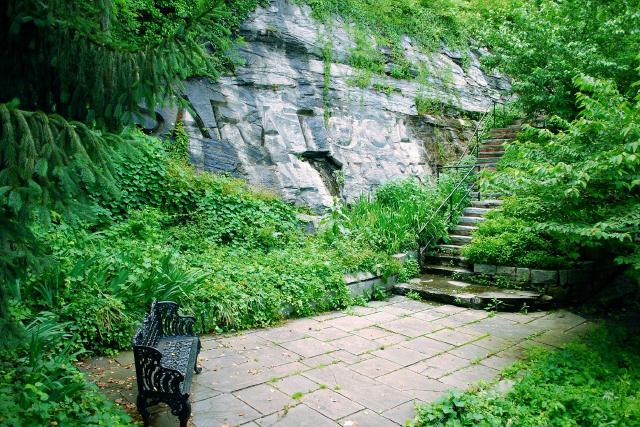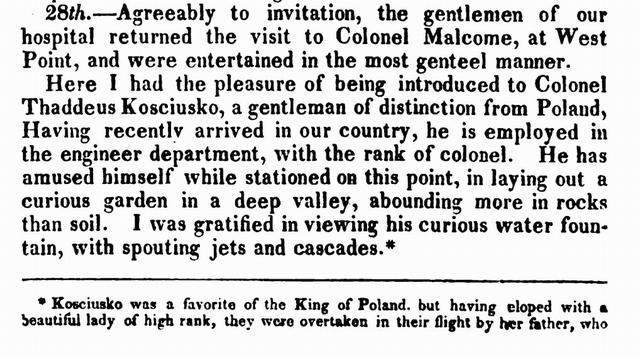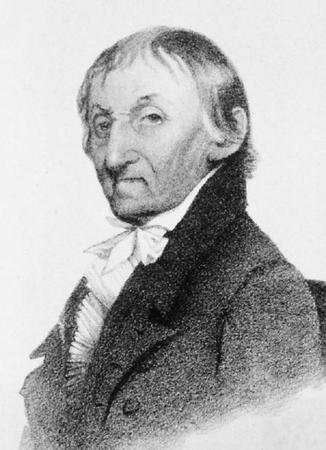| Let me take you to a very special place, to the the secret garden of Thaddeus Kosciuszko. In a moment I will tell you the whole story. But first, listen to the trickling tipper tapper of the fountain,
look around and see the steps which lead down to this little place of serenity. It was established in 1778. While serving as Fortifications Engineer for West Point, Kosciuszko selected a site for his Garden. And, since he had chosen it to be a personal place of serenity and contemplation, he never asked or ordered soldiers, civilian labourers, or prisoners of war to help him clear away the wild vegetation or to channel the mountain stream, or to carry soil down to the rock-bound Garden from the Plain overlooking it by way of a precipitous footpath so that he could transplant wild flowers and other foliage conducive to ornamental cultivation in vogue for those times.
"The Garden is about thirty feet in length, and in width, in its utmost extent, not more than twenty feet, and in some parts much less. Near the center of the Garden there is a beautiful basin, near whose bottom, through a small perforation, flows upward a spring of sweet water, which is carried off by overflowing on the east side of the basin toward the River, the surface of which is some eighty feet below the Garden. It was here, when in its rude state, the Polish soldier and patriot sat in deep contemplation on the loves of his youth, and the ills his country had to suffer. It would be a grateful sight to him if he could visit it now, and find that a band of youthful soldiers had, as it were, consecrated the whole military grounds to his fame” - these are the words written in 1834 by Samuel Knapp of New York.
Benson J. Lossing visited the garden in 1848 and was full of praise."Emerging from the remains of Fort Clinton, the path, traversing the margin of the cliff, passes the ruins of a battery, and descends, at a narrow gorge between huge rocks, to a flight of wooden steps. These terminate at the bottom upon a grassy terrace a few feet wide, over which hangs a shelving cliff covered with shrubbery.

Tracy H. Sugg: Kosciuszko and Agrippa Hull in the Garden |
This is called Kosciuszko’s Garden, from the circumstance of its having been a favourite resort of that officer while stationed there as engineer for a time during the Revolution. In the center of the terrace is a marble basin, from the bottom of which bubbles up a tiny fountain of pure water. It is said that the remains of a fountain constructed by Kosciuszko was discovered in 1802, when it was removed, and the marble bowl which now receives the jet was placed there. It is a beautiful and romantic spot, shaded by a weeping willow and other trees, and having seats provided for those who wish to linger.”
This story was soon (1850) published in "Pictorial Field Book of the Revolution".
It seems that the garden was built during winter. A blogger remarked in 2014: "There’s still no sign of spring yet at West Point - only forecasts of more snow. It’s how winter is now and it’s how it was when Kosciuszko spent his two years here. The winter of 1779 at West Point was one of the worst during the Revolution.
Kosciuszko knew that when the river began to thaw in March he needed to get the Great Chain strung across to Constitution Island. In The River and the Rock, LTG Dave Palmer notes that: Kosciuszko had won his struggle to obtain and prepare enough new logs to float the chain, but he was stymied for want of ‘two large coils of cable and one sloop, without which we cannot proceed.’ It was probably then, as the harsh winter began to wane and the supply of crucial supplies slowed down, that Kosciuszko built his garden.

Kosciuszko's Garden in 2009 |
In the dead of winter, any gardener can relate to obsessive dreaming about the possibility of growing plants, flowers and vegetables if, and when, the sun ever shows up, and Kosciuszko was no different. So driven by the need to break the monotony of winter and leave gloom period behind, he built the garden.
Why building a garden amongst the rocks? Was it that rocks brought back some memories from Poland? Thaddeus, as a child, back at Mereczowszczyzna, played in the garden dominated by a large boulder. Standing on it he could see the world around. The location of the garden at West Point was not easy to access, but provided privacy for the young engineer for “rest and repose.” As you could see on the video, Kosciuszko made a round bed of rocks to contain flowers that reminded him of Poland. In order to get soil to the garden for the plantings he had to drop it down from a pail above the cliffside you see today,left from Southern Campaign. Would he ever imagine that the garden would survive for almost 240 years, being a place of “rest and repose” for cadets cadets of so many generations?
Throughout the 19th century, the Hudson River Valley and West Point became major tourist attractions for many Americans living in the downstate New York - northern New Jersey area. These attractions were fuelled by the success of the "Hudson River School" of American Painters, on the one hand, and the other being the popular book Tales from the Garden of Kosciuszko
by Samuel L. Knapp, published in 1834 by West and Trow.
It is considered one of the oldest continuously existing gardens in the United States. It has been well taken care of. The "General Edward L. Rowny Family Endowment" was established to further sustain perpetual care and maintenance of the Garden and to dedicate a plaque commemorating the occasion.
Kosciuszko did not keep the place just to himself. It became one of the camp's attraction. Now and then he entertained guests here. One of them was a continental army surgeon, dr James Thacher who left an interesting note in his diary (Military Journal of 28th July 1778).) "Agreeably to invitation, the gentlemen of our hospital returned the visit to Colonel Malcolme, at West Point, and were entertained in the most genteel manner. Here I had the pleasure of being introduced to Colonel Thaddeus Kosciusko, a gentleman of distinction from Poland. Having recently arrived in our country, he is employed in the engineer department, with the rank of colonel. He has amused himself while stationed on this point, in laying out a curious garden in a deep valley, abounding more rocks than soil. I was gratified in viewing his curious water fountain, with spouting jets and cascades".
It was probably here that Kosciuszko told dr Thacher about his botched elopement with his beloved Ludwika Sosnowski. Next to Thacher's description of the garden we find an interesting footnote which reads:
* Kosciusko was a favourite of the King of Poland, but having eloped with a beautiful lady of high rank, they were overtaken in their flight by her father, who made a violent attempt to rescue his daughter. Kosciusko was reduced to the alternative of destroying the parent or of abandoning the object of his affections. Disdaining the atrocious deed, he sheathed his sword, and soon after, having obtained permission of his sovereign to quit Poland, he resorted to America, where he resolved to execrcise his gallantry in a new sphere of action."

Dr J. Tchacher's Military Journal |

Dr James Thacher |
And on the other side of the globe, Ludwika and her husband Prince Joseph Lubomirski, were preparing for a trip to Warsaw, to visit the old Prince Lubomirski. Ludwika was anxious to find out where Thaddeus was and what was he doing. The only person who might have been in touch with Thaddeus was Prince Adam Czartoryski. Ludwika asked her husband to stop on their way to Warsaw at Sieniawa, where Prince Adam resided at that time. She must have secretly enquired about her beloved one as it was well documented that in October 1778 Prince Adam had asked his correspondent in Paris to contact ambassador Franklin to find out Kosciuszko's whereabouts. Soon after Julian Ursyn Niemcewicz, Kosciuszko's friend, advised Ludwika he was in touch with Thaddeus and received news about his life in America. 3 years on (5th of May 1781) Ludwika had written a letter to Thaddeus assuring him of her feelings. She explained that she had told her husband that her heart would never stop beating for Thaddeus. When Kosciuszko received this letter, he was already at Ninety Six, miles away from the rocky garden of West Point. Could he ever imagine that 7 years later Princess Lubomirska would write a letter to King Stanislaw August Poniatowski asking him to offer a job to general Kosciuszko in the newly reformed Polish Army.
| 

